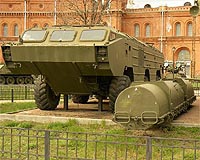| . |  |
. |
Tel Aviv, Israel (UPI) Nov 3, 2009 Israel's military intelligence chief has warned that Palestinian militants in the Gaza Strip have successfully tested an Iranian rocket that can reach Tel Aviv, the Jewish state's largest urban conurbation. That adds a new urgency to Israel's efforts to develop an effective defensive system capable of shooting down short-range rockets that, if the warning by Maj. Gen. Amos Yadlin is correct, are becoming a strategic threat. Yadlin says the rocket has a range of 37 miles, 8 miles longer than the Grad rockets Hamas and its allies in the Gaza Strip have been firing in recent months. He did not identify the Iranian system, but there have been reports that Iran has been seeking to smuggle Fajr-5 (Dawn) rockets into Gaza to give Hamas a longer reach. The Fajr-5 is an artillery rocket developed in Iran during the 1990s and is fired from a mobile launcher. It has a range of up to 50 miles. In January Israeli officials claimed Hamas had acquired dozens of Fajr-3 missiles, with a range of 25 miles, and that these were used to hit the Negev town of Beersheba. These have largely supplanted the short-range Qassam rockets made by Hamas in its clandestine workshops around the Gaza Strip. There were concerns that the nuclear reactor at Dimona, 20 miles east of the biblical city, could also become a target. If Hamas does have Fajr-5s, then that nightmare scenario has become real. According to Jane's Defense Weekly, Syria has decided to provide the Iranian-backed Hezbollah movement in Lebanon some 250 of its 800 M600 surface-to-surface missiles. The M600 is a clone of Iran's Fateh-110 missile, which has a range of 160 miles, carries a 225-pound warhead and, unlike most of the short- and medium-range missiles currently arrayed against Israel, has an inertial guidance system. This would give Hezbollah new precision capabilities. The Israelis believe the Iranians seek to eventually put all of Israel under threat from these missiles from Lebanon in the north and Gaza in the south, while targeting the Jewish state with its long-range Shehab and Sajjil ballistic missiles. To counter these multiple threats, Israel has the Arrow-2 anti-ballistic missile for long-range, high-altitude defense, with the Kippat Barzel (Iron Dome) and (Kela David) David's Sling systems to cover the medium- and short-range threats. The first Iron Dome battery is expected to be deployed in the southern Negev in 2010, while David's Sling is scheduled to become operational in 2012-13. The Raytheon Co. of the United States last month was awarded two contracts worth in excess of $100 million by Israel Rafael Advanced Defense Systems to develop the David's Sling Weapons System to counter short-range ballistic missiles, large-caliber rockets and cruise missiles in their terminal phase of flight. That is a joint program between the Missile Defense Agency and the Israel Missile Defense Organization. One contract was awarded to co-develop the Stunner Interceptor, the system's missile component. The other was for the development, production and integrated logistics support of the missile firing unit, the system's launcher. Meantime, Israel's military is expected to soon take delivery of the new Raz radar system, which can detect the firing of mortar shells, a tactic widely used by Hamas on the Gaza front, with more accuracy and at greater ranges than systems currently operational. It is scheduled for deployment during 2010. An early variant of the Raz was successfully tested during Operation Cast Lead, the 22-day invasion of the Gaza Strip by the Israeli army on Dec. 27. Cast Lead's stated purpose was to eliminate Hamas' rocket and mortar fire into Israel, and since that operation was concluded on Jan. 18 the attacks have been virtually eliminated. Share This Article With Planet Earth
Related Links Learn about missile defense at SpaceWar.com All about missiles at SpaceWar.com
 NKorean Missile Tests Fail; China "Formally Invites" Kim For A Visit
NKorean Missile Tests Fail; China "Formally Invites" Kim For A VisitSeoul (AFP) Oct 29, 2009 North Korea's short-range missile tests earlier this month were a failure with none of the five projectiles reaching its target, a report said Thursday. The North test-fired five KN-02 missiles with a range of 120 kilometres (75 miles) from mobile launchers off its east coast on October 12. Radio Free Asia, quoting an intelligence source, said four of the five missed the mark and one ... read more |
|
| The content herein, unless otherwise known to be public domain, are Copyright 1995-2009 - SpaceDaily. AFP and UPI Wire Stories are copyright Agence France-Presse and United Press International. ESA Portal Reports are copyright European Space Agency. All NASA sourced material is public domain. Additional copyrights may apply in whole or part to other bona fide parties. Advertising does not imply endorsement,agreement or approval of any opinions, statements or information provided by SpaceDaily on any Web page published or hosted by SpaceDaily. Privacy Statement |